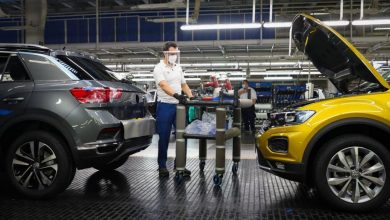
Smart factories – driving the automotive industry into the fast lane
Services giant Capgemini's latest study into smart automation focuses on the car industry.
The car market is changing, with most automakers now classing themselves as technology companies rather than makers of tin boxes that haul humans from A to B. Cars are changing too, with electric, connected, and autonomous vehicles making their way onto our roads, and historic ownership models being challenged.
Even the concept of a driver is changing, with the US amending regulations in 2018 to acknowledge that drivers may soon have time-of-flight sensors and lines of code instead of eyes, hands, and DNA.
So it’s no surprise that car manufacturing is being transformed as well. As the Industrial Internet of Things (IIoT) grows, as robots take on replicable processes, and as analytics, AI, cloud platforms, digital twins, augmented reality, additive manufacturing (3D printing), and 5G promise multimillion-dollar gains, automakers want a piece of the smart factory action.
In some cases they are leading the market in implementing change in areas such as real-time information management, industrial control systems, intelligent automation, energy usage, and enhanced operations. But they have a long, bumpy road ahead of them before they can realise the full potential of these initiatives. That’s the conclusion of a new report from Capgemini, How automotive organizations can optimize the smart factory potential.
The report argues that cloud computing and 5G are now deemed more crucial to success by automakers than automation, machine learning, augmented operations, robotics, analytics, or additive manufacturing (which seems to be falling out of favour, despite progress in printing metal parts).
According to the services giant, automotive firms plan to convert 44% of factories into smart facilities over the next five years, with a view to driving a range of benefits. These include: new productivity gains; improved efficiency; stock reductions; quicker decisions; faster response times; greater business insight; lower energy usage; and overall cost savings. This puts them in the vanguard of modernisation in the manufacturing industry.
Capgemini spoke to 100 leading executives in automakers across 11 countries –principally Germany, the US, India, France, Japan, and the UK – each of which had 2019 revenues of over $1 billion. Its researchers found that 98% of the companies have a smart factory initiative of some kind underway and nearly half (48%) say that they are making good progress against their strategic roadmap for it – up from 38% in a previous study in 2017-18.
Nearly one-third (30%) of automakers’ factories have undergone a degree of smart transformation over the last three years, up from 24% in the earlier survey.
The report cites Dr Seshu Bhagavatula, President of New Technologies and Business Initiatives at Ashok Leyland, one of the largest heavy vehicle manufacturers in India, who said:
There are three primary reasons why we took up the smart factory initiative. The first is to improve the productivity of our old factories through modernising and digitising their operations. The second is to deal with the quality issues that are difficult for human beings to detect. And the third is to incorporate made-to-order or mass-customisation capabilities.
So it is not just about making the business more efficient, but also catering for emerging customer preferences.
The report shares a number of case studies. For example, Mercedes-Benz can now simulate its entire production process with virtual tools, and uses advanced data analytics to create self-learning and self-optimising production systems. Meanwhile, Renault is deploying collaborative robots (cobots), autonomous guided vehicles, and augmented worker technologies to produce a new vehicle every four seconds.
Overall, the smart factory prize could be worth $167 billion to the industry, says Capgemini. That’s great news, but there is a problem: while carmakers’ ambitions for smart factories are high, delivering big results from them is quite a different matter, says the report.
While the 100 companies in the survey have set improvement targets at upwards of 35% against a range of key performance indicators, most have only achieved results of 15% at best, with many faring significantly worse. Still, those are measurable improvements.
Audi’s Mexican plant has shown that it is possible to gain benefits in excess of 30%, yet results of that magnitude remain out of reach for most automakers or projects. But why? The report says:
A large majority of them have to address certain areas before they could achieve scale and seize the smart factory prize. To achieve their goals, both OEMs and suppliers will need to accelerate on a number of priorities, including strategy, integrated systems solutions, IT-OT convergence, and a talent reboot.
The findings build on Capgemini’s 2019 report, Smart Factories at Scale, from which some of the research is taken. That report found that only 14% of 1,000 manufacturers of every type worldwide describe their forays into smart manufacturing as successful, with nearly two-thirds saying that they are struggling to scale programmes from testbed to factory to enterprise.
Complexity, legacy technology, security fears, lack of skills, cultural resistance, and poor integration between operational technology and IT departments make transforming a traditional sector a more complex and frustrating experience than the evangelists acknowledge.
On the security question, recent reports reveal that hackers are increasingly targeting the IoT and industrial control systems (ICS); new ransomware variants reported in December and January lock up ICS functions and demand cryptocurrency payments to release them.
One-quarter of all manufacturers have experienced a cyber-attack on their connected systems over the last year, and the impetus behind it is invariably financial. The conclusion is inescapable: organised criminals see smart factories as an easy target.
Exposing plants to networks when they were never designed for the networked world is one part of the problem – one shared by the healthcare sector, where medical devices are specialist, expensive, regulated, and can’t simply be ripped out and replaced.
Another challenge for business and IT leaders is whether to adopt a greenfield or brownfield approach to their smart factory. Logic dictates that it is better to design something from the ground up than to retrofit ageing systems, but it is also a lot more expensive:
One in four auto firms are prepared to invest in a greenfield factory strategy. In our previous research, we estimated the cost of setting up a new greenfield factory for a top-ten auto OEM to be between $1 billion to $1.3 billion. In comparison, the cost for a brownfield setup was estimated to be between $4 million to $7.4 million per factory. Given the costs involved, it is perhaps not surprising that 44% intend to follow a hybrid approach, combining both greenfield and brownfield implementations, and 31% intend to pursue brownfield opportunities. However, a quarter (25%) intend to pursue a greenfield strategy, and this drops to 20% for the manufacturing sector as a whole.
How to win
According to Capgemini, automakers have invested an average of around 2.2% of revenue in smart factory programmes, with a predicted rise to 3.5% by 2023 – higher than the manufacturing average. But with annual revenues of $1 billion or more per company, that’s expenditure in the tens of millions.
Despite the cost of greenfield approaches being equivalent to a year’s revenue, the appetite among some automakers for a fresh start stems from more than half of them (56%) saying that a factory should be efficient by design, not just in operation. That’s far easier to accomplish in a Greenfield environment.
So what does the industry need to do to match the ambitions of its leading few? Arry Balachandran is Capgemini’s Automotive Managing Consultant. He told me:
5G, big data, cloud computing, and automation, they pretty much now define what a smart factory is, but trying to utilise those kinds of technologies only gets you so far. What we’ve seen with automotive organizations is good brownfield development, such as retrofitting plants with IoT devices and trying to put in a data platform, gets them so far down the road. But it doesn’t make the massive leaps that a greenfield investment would.
Embracing those technologies gets you, maybe, some gains, but it doesn’t get you the benefits of scaling, unless you build the right foundations. And those foundations are the same as they always were: It’s about having good IT convergence with operational technology, and building strong platforms. And ultimately, it’s paying attention to people.
As to what characterises a leader in this space, Balachandran said:
Automakers have pressure from a number of areas: sustainability, trust and perception, and customer experience. So this means that it’s very important to protect margin. They need to create more flexibility with their production and create more personalisation. All of these factors mean that they’re driven to move further and move quicker. I think that’s why we see them leading the pack.
Skills are another challenge across the entire manufacturing sector, as Capgemini’s 2019 report explored. Developing hybrid job profiles, such as engineering/manufacturing, manufacturing/maintenance, and safety/security is essential for smart factory success, as is nurturing ‘soft’, human-centric skills like problem-solving and collaboration.
However, organizations are not investing fast enough to fill these gaps. At the same time, it’s likely that the job market has yet to be flooded with high-end, hybrid skills – an opportunity for anyone who sets out to acquire them.
Either way, the human element can’t be ignored in a smart factory programme. As Chi Onwurah, the UK’s Shadow Minister for Industrial Strategy, Science, and Innovation, observed at a recent conference, technology isn’t something that just happens to us passively; we all have a role in adopting and shaping it – or even rejecting it.
This was underlined in another recent report on the age of automation, this time from training providers MindEdge and Skye Learning. Titled ‘Preparing for Robot Colleagues: A New Decade of Robomageddon’ (and thus risking confirmation bias), the survey revealed the doublethink at play among many manufacturing workers.
On the one hand, one-third of the more than 1,000 employees surveyed said that Industry 4.0 technologies are already in their workplaces, 76% that new technology has made their jobs easier, 69% that it has had a positive effect on morale, and 65% that it has freed them to focus on higher-value-adding work. But on the other, 57% say that automation is still bad for American workers.
So what does Balachandran think about the cultural and skills challenges on the road to smart factory success? He said:
We spend a lot of time with companies on organisational change, governance challenges, and on people – understanding roles, training and reskilling. And I think the level of dissatisfaction [mentioned in some reports] is a natural occurrence of not paying attention to those things: the idea that you can simply bolt on technology and not address them.
Something else that has emerged from recent reports on implementing automation, AI, and robotics, is that many organisations rush into deployment for the wrong reasons: to make quick costs savings and staffing cuts, rather than to invest strategically in making the business smarter. Balachandran responded:
In taking a minimum viable product or incremental approach, the risk is that you fall into the trap of doing exactly that: looking for quick wins. But part of the move to scaling a smart factory is keeping the goal in mind.
It’s okay to move incrementally and to have some of these quick wins, because it helps you build a business case and get the stakeholders you need on board. But if you don’t keep the strategic end in mind, that’s where you’ll stay: with these very small, known, scalable improvements, rather than implementing something that is more revolutionary and has greater impact.
My take
And that, presumably, is where Capgemini’s sales team comes in – especially if their client wants to spend a billion dollars to start a revolution.
Balachandran said:
A lot of a lot of our work is in helping organizations develop a digital mindset at leadership and senior governance level, but it has to go all the way through the organization. It’s very easy for organizations to implement technology and then hope that at grassroots level people will embrace it and use it. But it has to be driven by senior leadership.
It seems that someone still needs to be in the driver’s seat – even in 2020.
Font: Diginomica





